
94% of researchers rate our articles as excellent or good
Learn more about the work of our research integrity team to safeguard the quality of each article we publish.
Find out more
ORIGINAL RESEARCH article
Front. Hortic. , 22 December 2022
Sec. Olericulture
Volume 1 - 2022 | https://doi.org/10.3389/fhort.2022.1091342
 Thomas W. Ingram1
Thomas W. Ingram1 Suzette Sharpe2
Suzette Sharpe2 Marlee Trandel3
Marlee Trandel3 Penelope Perkins-Veazie3
Penelope Perkins-Veazie3 Frank J. Louws1,4
Frank J. Louws1,4 Inga Meadows2*
Inga Meadows2*Grafting high yielding tomato cultivars (Solanum lycopersicum L.) onto vigorous rootstocks can increase marketable yields, but questions remain regarding optimal cultural and growing conditions such as pinching and plant spacing. This study addressed some of the dynamics between grafted plants and cultural practices. Two scions, ‘Tasti-Lee’ (TL) and ‘Mountain Fresh Plus’ (MFP) were grafted onto each of three rootstocks, ‘Beaufort’, ‘Arnold’, and ‘Shield’. Plants were pinched (removal of main shoot to induce both axillary shoots to grow) or non-pinched, and spaced at 56 or 61 cm. All 32 grafted treatments were compared to the grower standard: non-grafted TL and MFP spaced at 46 cm, which were non-pinched. Fruit quality traits including soluble solids content, pH, lycopene concentration, and titratable acidity were recorded for fruit harvested from tomatoes grafted onto ‘Arnold’, ‘Beaufort’, ‘Shield’ and non-grafted TL. The overall effect of grafting TL and MFP onto vigorous rootstocks ‘Arnold’, ‘Beaufort’, and ‘Fortamino’ increased marketable yields per hectare by 24-35% compared to non-grafted grower standards. The rootstock ‘Shield’ did not significantly increase yields with either scion. TL had a more positive response to grafting than MFP. ‘Arnold’, ‘Beaufort’, and ‘Fortamino’ significantly increased TL fruit size, but the fruit size results were not as significantly impacted by graft treatments for MFP. Plants spaced at 56 compared to 61 cm generated similar yields. Pinched plants significantly increased yields over non-pinched plants by 15% in 2018 but did not impact yield in 2017. No consistent difference was observed between pinched and non-pinched plants with regard to fruit size, only plants grafted with ‘Shield’ benefited significantly from being pinched. Soluble solids content, pH, total lycopene concentration, and titratable acidity differed slightly between grafted and non-grafted plants but was unlikely to positively or negatively affect overall perception of fruit quality in tomatoes. A partial budget analysis revealed that grafting with ‘Arnold’ or ‘Beaufort’ consistently increased profits in this low-disease field.
In the United States and the world in general, the amount of arable land per capita has been decreasing for many decades (World Bank, 2015). Increased restrictions on the use of chemical fumigants, such as the phase-out of methyl-bromide, to manage soilborne pathogens has compounded this problem (Miguel, 2002; Louws, 2010). Growers are struggling to produce the same yields on lower quality and smaller areas of land (Qiao et al., 2015). Grafting presents a unique solution to this problem by allowing growers to select preferred vegetable varieties/scions for grafting onto vigorous and/or disease resistant rootstocks (Harrison and Burgess, 1962; Louws et al., 2010; Rivard et al., 2010a; Grieneisen et al., 2018). The hardiness, disease resistance, or vigor of rootstocks can improve yield of grafted scions, specifically fresh market tomato (Solanum lycopersicum Mill.) cultivars (Lee, 1994; Oztekin et al., 2009; Grieneisen et al., 2018). The use of grafted plants is common in greenhouse vegetable production but has not been as widely adopted in field production systems in the USA (Kubota et al., 2008).
Although some tomato rootstocks can provide high levels of resistance or tolerance to a wide variety of plant pathogens (Harrison and Burgess, 1962; Grimault and Prior 1994; Ioannou, 2001; Rivero et al., 2003; Louws et al., 2010), little is known on the yield response of scions with vigorous rootstocks in the presence of low soilborne pathogen pressure (Suchoff et al., 2019). In a recent meta-analysis, grafted plants yielded similarly or less than non-grafted or self-grafted plants 65% of the time (Grieneisen et al., 2018). Additionally, specific conditions affect graft response in yield, such as scion choice with the rootstock ‘Maxifort’ (Loewen et al., 2019). These inconsistent results indicate a need to specify and optimize practices where grafting can increase yields beyond pathogen pressure. As grafted plants cost appreciably more per plant than non-grafted, grafting nursery businesses and growers must realize a positive return on investment to consider adopting the practice (Rysin and Louws, 2015).
Pinching, the removal of meristems to allow two axillary stems to grow, has been shown to increase yields in grafted and non-grafted tomatoes in hydroponic systems (Rahmatian et al., 2014). Hypothetically, two main stems with one large vigorous root system should allow growers to plant at a decreased density. However, in the field, pinching has not been sufficiently evaluated to understand if this practice affects yield (Suchoff et al., 2014). Currently, pinching is employed by growers without a thorough understanding of the exact parameters under which this practice should be used.
In standard tomato field production in North Carolina and surrounding states, non-grafted tomato plants are spaced at approximately 46 cm between plants. One study in the region suggested grafted plants can be spaced farther apart due to the increased vigor of the rootstocks and associated increase of fruit production (Suchoff et al., 2014). Grafted tomato plants are recommended to be spaced at 56-61 cm (Tri-Hishtil, personal communication), but limited data regarding yield at these spacings is sparse (Kubota et al., 2008). Increased yield can be realized by harvesting more fruit and/or larger fruit. Spacing plants farther apart is a feature of grafted plants which allows for a greater return on investment (Miguel, 2002; Rivard et al., 2010b; Barrett et al., 2012; Suchoff et al., 2014).
Although increasing yield and fruit sizes is important, fruit quality (color, sweetness, acidity) must also be maintained or improved as compared to non-grafted tomato plants. The effect of grafting on fruit quality in solanaceous and cucurbitaceous plants has been mixed. Reports for specific rootstock-scion combinations have shown slightly better, slightly worse, or no changes in fruit composition compared to non-grafted or self-grafted tomatoes, (Pogonyi et al., 2005; Riga et al., 2016; Kyriacou et al., 2017). Although overall differences reported are small enough that marketability would not be affected, the variability of effects of grafting warrants evaluation of quality and marketability.
The impact of pinching, spacing, and grafting has been studied either independently or in greenhouse systems. Information on combinations of these cultural practices on fresh market tomato under field production is lacking. The objectives of this study were to evaluate yield effects impacted by (1) grafted Tasti-lee (TL) and Mountain Fresh Plus (MFP) plants onto rootstocks ‘Beaufort’, ‘Arnold’, ‘Shield’, and ‘Fortamino’ and non-grafted; (2) pinched and non-pinched plants; (3) spacing effects; (4) to evaluate fruit quality including lycopene concentration, pH, titratable acidity, and soluble solids content (SSC) of fruit from grafted and non-grafted plants; (5) and to conduct a partial budget analysis to determine the effect of these practices on profits.
This study was conducted in 2017 and 2018 at the Mountain Horticultural Crops Research and Extension Center (MHCREC) in Mills River, NC (35°25’36.5”N 82°33’33.0”W). Treatments were arranged in a randomized complete block design with four replicates. The experiment contained 34 treatment combinations in 2017 and 36 (because of the addition of ‘Fortamino’ treatments) in 2018 (Supplemental Table S1). The experiment was blocked for position in the field to account for variation in slope, with block one on the northmost part of the field and block 4 being on the southmost part of the field. Each block contained all treatment combinations in a randomized pattern. Each experimental unit, or treatment plot, was 9.14 m long and separated by a 1 m fallow section within the row. Grafted plants were planted at either 56 or 61 cm in-row spacing. Non-grafted controls were planted at the standard spacing of 46 cm. Seedlings were planted on 8 Jun 2017 and 6 Jun 2018 in raised beds, 30 cm high and 100 cm wide on 1.5 m row centers and covered with 1.5ml polyethylene black plastic. Because the field had not been planted in vegetables for over 20 years, soilborne pathogen pressure was expected to be low and the beds were not fumigated in 2017. In 2018, beds were fumigated with 90 kg/ha Pic-Clor 60 (37.1% 1,3 dichloropropene, 56.7% chloropicrin, 6.1% other ingredients) six weeks prior to planting. Beds were watered and fertilized through drip irrigation and pesticide applications were consistent with commercial tomato production in North Carolina (Ivors, 2010). Plants were trained using the stake-and-weave-system according to standard practices. Four weeks after planting all plants in this study were pruned by removing all the suckers up to the sucker below the first flower cluster. Plants grafted onto the rootstock ‘Beaufort’ also had identical non-pruned treatments, but the results from those plots are not reported in this study, and previously published (Ingram et al., 2019).
Grafting was conducted by Tri-Hishtil (Mills River, NC) using the splice grafting method. Commercial tomato (Solanum lycopersicum L.) cultivars ‘Tasti-lee’® (Bejo Seed, Oceana, CA [TL]) and ‘Mountain Fresh Plus’ (HMClause Seed Company, Davis, CA [MFP]) were grafted onto rootstocks ‘Arnold’ (Siegers Seed Co., Holland, MI), ‘Beaufort’ (DeRuiter Seeds, St. Louis, MO), and ‘Shield’ (Rijk Zwaan, De Lier, Netherlands). ‘Arnold’ is a hybrid rootstock thought to confer vigor (Loewen et al., 2019). ‘Beaufort’ was chosen because it is a commonly used rootstock and also thought to be vigorous. ‘Shield’ was used as it is a common choice for its resistance to bacterial wilt (Ralstonia solanacearum [Smith] Yabuuchi, Kosako, Yano, Hotta & Nishiuchi), although it is not considered a vigorous rootstock. ‘Fortamino’ (Enza Zaden Salinas, CA) was added in 2018 to gain information on a vigorous and Fusarium oxysporum f. sp. lycopersici race 3 resistant rootstock because of the emergence of race 3 in North Carolina at the time of this study (Adhikari et al., 2020). Non-grafted plants of both scion cultivars were used as controls. Transplants of non-grafted plants were grown in a greenhouse at MHCREC, under similar conditions as the grafted plants, for six weeks until transplanted.
All grafted plants were either pinched or not pinched (Supplemental Table S1). The apical meristem of each plant was removed 5-7 days before transplanting to allow the two axillary buds to sprout and produce two apical stems. All non-grafted plants were not pinched.
Vine-ripe tomatoes were hand-harvested on 14, 23, 30 August and 13, 25 September 2017 and 14, 23, 29 August and 6, 13 September 2018. All plants in each plot were harvested. At the final harvest both years, all the fruit on each plant was harvested (>2.5 cm diameter). All fruit was sorted into unmarketable and marketable, and the marketable fruit was sorted based on USDA size designations. Diameters of specific fruit sizes are: medium = 5.71 - 6.43 cm; large = 6.35 – 7.06 cm; extra-large (XLPlus) = >7 cm. Unmarketable fruit (culls) were determined by size (<5.71 cm) or fruit that had unmarketable fruit characteristics (zippering, cat-facing, rot). The weight and number of fruit in each category was recorded.
In 2018 only, after fruit were sorted and weighed, a subsample of fruit collected from TL grafted onto ‘Arnold’, ‘Shield’, or ‘Beaufort’ rootstocks that had been pruned, but not pinched, were compared to fruit from non-grafted TL at the second and third harvests to evaluate fruit quality characteristics. A total of 15 fruit were sampled from each rep, for a total of 60 fruit per treatment per harvest. Fruit were evaluated for soluble solids content (SSC%), pH, titratable acidity %, and total lycopene concentration. Fruit were frozen for 2 days at –20 °C, thawed, pureed with a blender, and further homogenized with a Polytron® PT 10/35 (Brinkmann, Midland, ON, Canada). An aliquot 0.5 mL of puree was placed on a digital refractometer (Atago Pocket Pal, Bellvue WA) and SSC was recorded. The pH of the undiluted puree was determined with a pH meter and a stainless-steel electrode (Hach, Loveland, CO). An aliquot of the concentrated puree was diluted (1:25) with deionized, distilled water and percent titratable acidity (as citric acid equivalents) was determined using a refractometer (Atago acid refractometer, Bellevue WA). Another aliquot of the concentrated puree was diluted (1:3) with deionized, distilled water and total lycopene content was determined using a colorimeter (HunterLab Ultra Pro Xenon, Columbia, MD) with absorbance at 560 and 750 nm (Panthee et al., 2013). Total lycopene (µg/g fresh weight) was calculated using the formula where m is slope and DF is the dilution factor:
Yield and fruit quality data were analyzed using PROC GLM in SAS 9.4 (SAS Institute, Cary, NC). Means for both years were separated using Tukey’s honestly significant difference test (P-value ≤ 0.05). Fruit size category data were analyzed using GraphPad Prism v8.0.2 (GraphPad Software, La Jolla, CA). Fruit category means were separated using 95% confidence intervals.
The ‘Added Revenue USD per Hectare’ for each specific treatment combination was determined by subtracting the cost of the treatment from the grower standard (non-pinched, pruned, non-grafted, 46 cm spacing). Fruit prices were calculated using the https://www.marketnews.usda.gov/shipping point price at the time the fruit was harvested. ‘Added Cost in USD per Hectare’ was determined by subtracting the cost of grower standard from the cost of the specific treatment combinations. Prices of specific rootstock-scion-pinching combinations were supplied by Tri-Hishtil in a personal communication. The time it took to prune one plant was calculated by timing four trained field technicians as they pruned each rep, one trainer per rep. The cost of pruning per plant was calculated assuming a minimum wage of 7.25 USD. The cost of non-pinched grafted plants ranged from 0.91-1.30 USD per plant depending on the rootstock scion combination. Scaling costs included the 25 lb. boxes (1.50 USD) used to pack the fruit, and labor costs associated with picking (0.22 USD/kg) and packing (0.11 USD/kg) the fruit. ImageGP was used to plot the results of the partial budget analysis (Chen et al., 2022). A breakdown of costs assessed in this analysis is available in supplemental table S2.
Rootstock was the only effect to significantly increase yield in both years (Table 1). In 2017 and 2018, marketable yield (kg/ha) was significantly greater from both MFP and TL grafted onto the rootstocks ‘Arnold’ and ‘Beaufort’, compared to the non-grafted grower standard (Table 2). MFP and TL generated similar yields (P<0.05) so these data were combined (Table 2). ‘Shield’ did not increase yield in either year nor for each scion compared to non-grafted plants (Table 2). ‘Fortamino’, evaluated only in 2018, increased yield (kg/ha) by 33.5% in TL and 29.2% in MFP. There was no year effect on marketable yield MFP XLPlus and large fruit sizes were not significantly greater when MFP was grafted on any rootstock, compared to fruit from the non-grafted plants (Figure 1). TL XLPlus and large fruit sizes were significantly greater when grafted on ‘Arnold’, ‘Beaufort’, and ‘Fortamino’, but not on Shield as compared to fruit from the non-grafted plants (Figure 2). Bacterial spot and Verticillium wilt disease ratings were taken, incidence was low, and were not impacted by any of the main effects and had no significant impact on yield. All yield results are available in Supplemental Tables S3, S4.
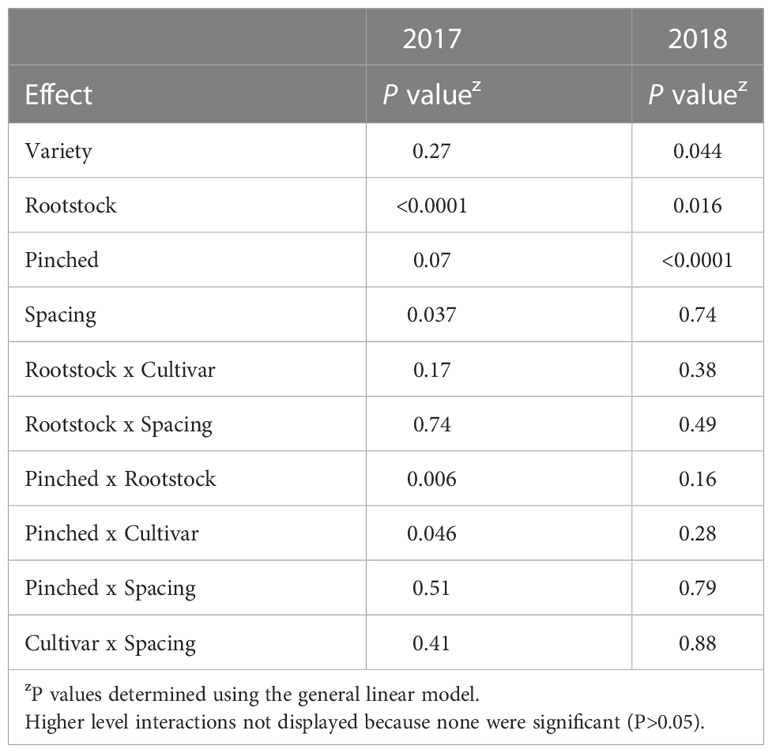
Table 1 Significance of main effects and interactions, based on their ability to influence the marketable yield.
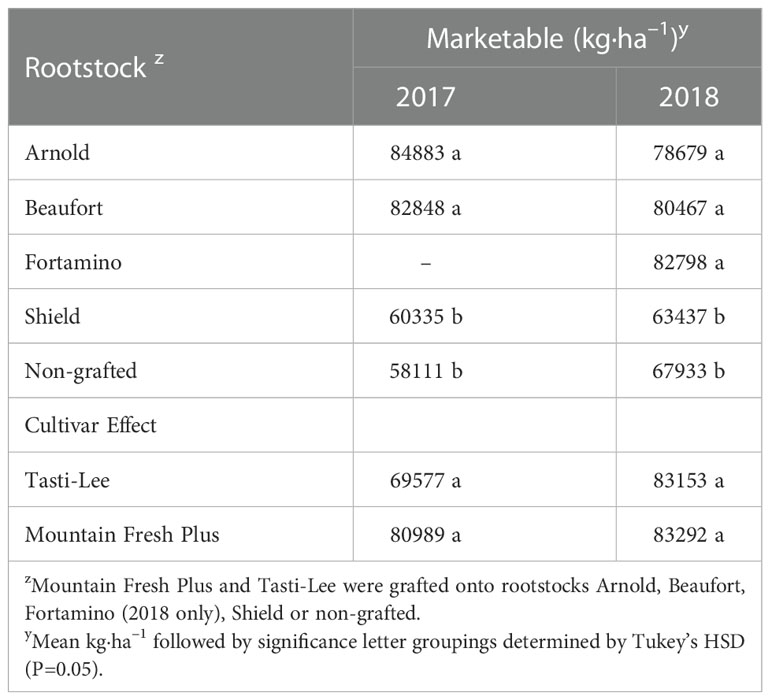
Table 2 Marketable fruit (kg/hectare) from grafted and non-grafted tomato plants from trials conducted in 2017 and 2018 in Mills River, NC.
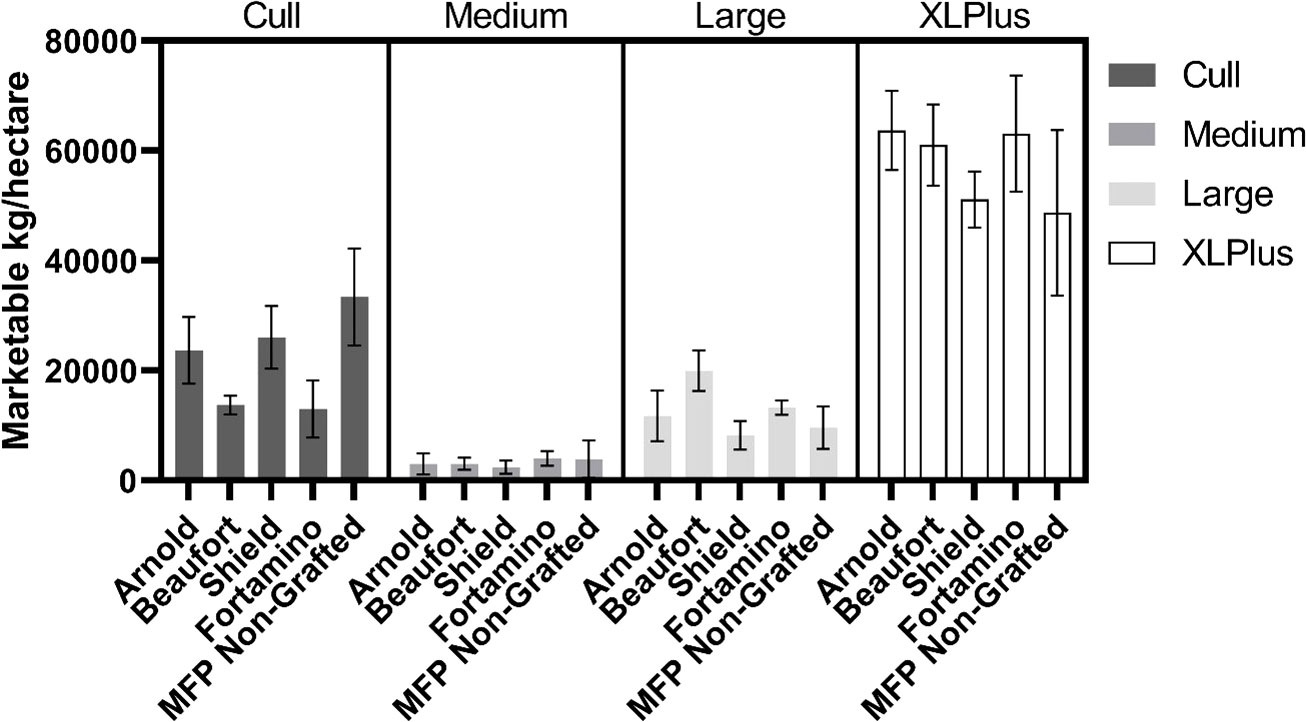
Figure 1 Fruit category distribution from pruned, non-pinched, grafted and non-grafted MFP tomatoes, 2017 and 2018 combined. Error bars represent the 95% confidence interval. ‘Fortamino’ was only planted in 2018.
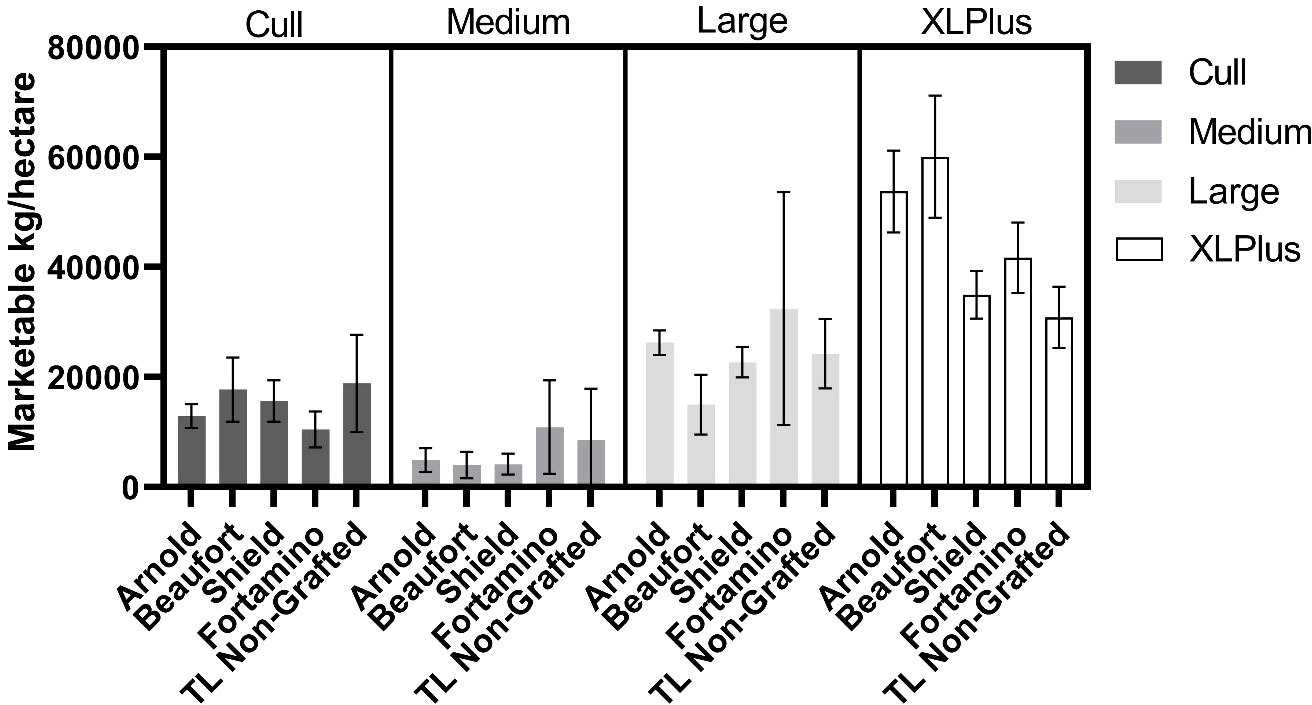
Figure 2 Fruit category distribution from pruned, non-pinched, grafted and non-grafted TL tomatoes, 2017 and 2018 combined. Error bars represent the 95% confidence interval. ‘Fortamino’ was only planted in 2018.
Pinching significantly increased marketable yields by 17.2% in 2018, however, the effect was not significant in 2017 (Table 3). Pinching interacted with both cultivar and rootstock in 2017, but this interaction was not repeated in 2018 (Table 1). For MFP both in 2017 and 2018 there was no significant difference between pinched and non-pinched fruit sizes (Figures 3, 4). In contrast non-pinched TL plants had significantly more large and XLPlus fruit sizes in 2017 (Figure 5). In 2018 the exact opposite effect was observed, with pinched TL having significantly more large and XLPlus fruit sizes than non-pinched TL (Figure 6).
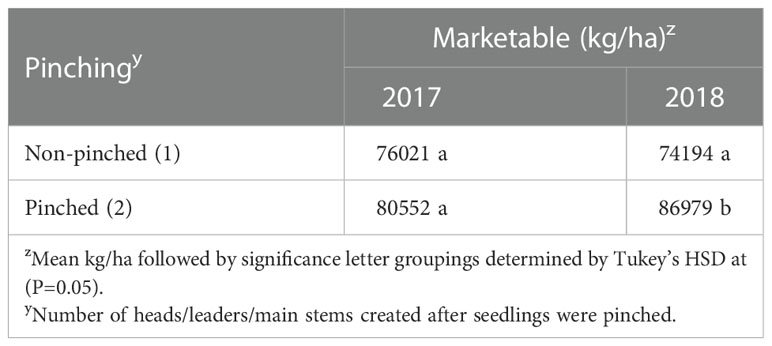
Table 3 Marketable fruit from pinched and non-pinched grafted plants from trials conducted in 2017 and 2018 in Mills River, NC. No cultivar or rootstock interaction detected (P>0.05); reported yields are combined from TL and MFP plants.
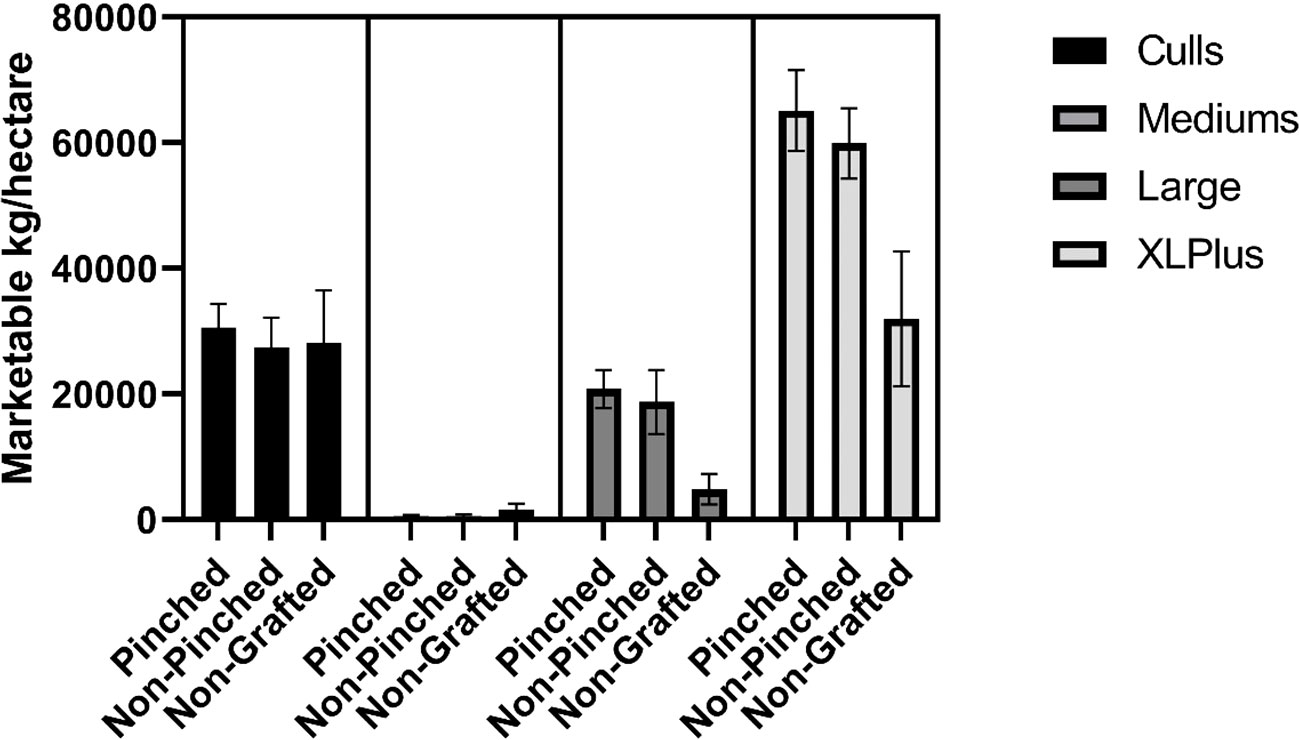
Figure 3 Mean fruit category distribution of all pinched and non-pinched MFP tomatoes in 2017. Error bars represent the 95% confidence interval. Non-grafted plants were all non-pinched.
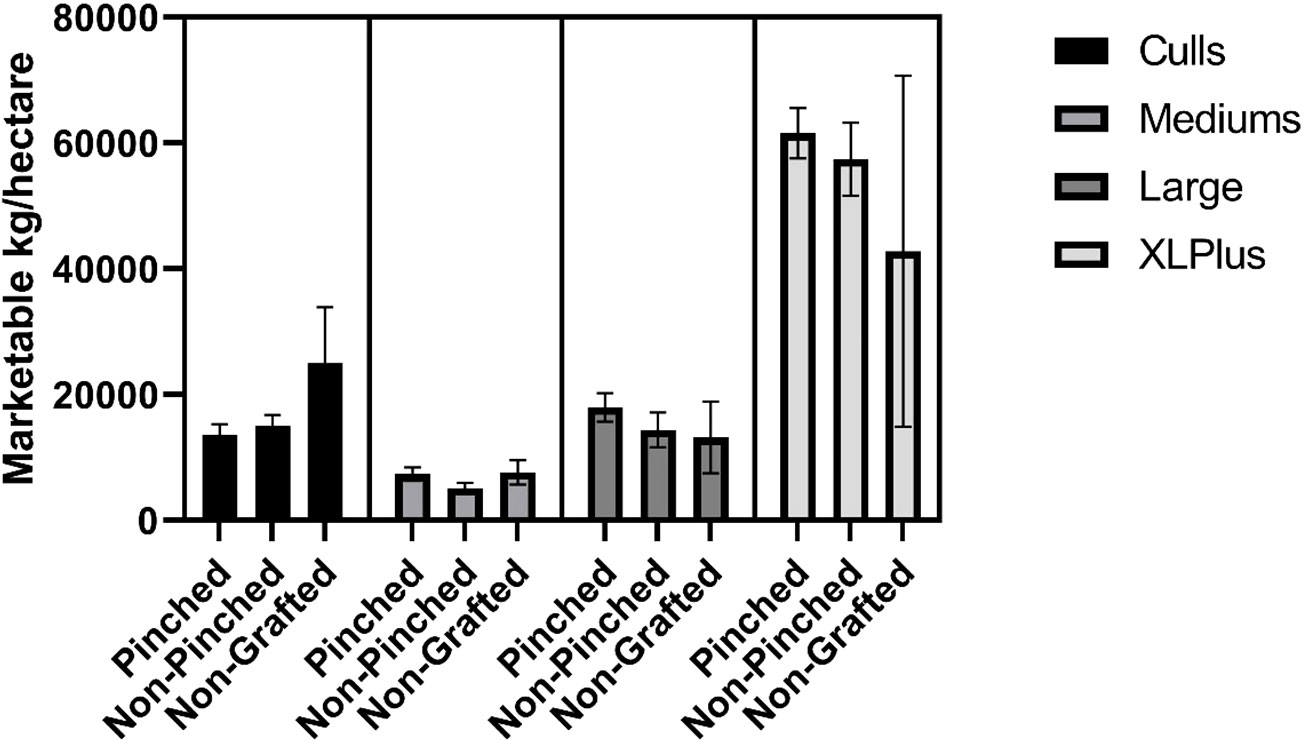
Figure 4 Mean fruit category distribution of all pinched and non-pinched MFP tomatoes in 2018. Error bars represent the 95% confidence interval.

Figure 5 Mean fruit category distribution of all pinched and non-pinched TL tomatoes in 2017. Error bars represent the 95% confidence interval.

Figure 6 Mean fruit category distribution of all pinched and non-pinched TL tomatoes in 2018. Error bars represent the 95% confidence interval.
In 2017 56 cm spaced plants had slightly higher yields than grafted plants at 61 cm (81588 vs 77343 kg/ha) (P = 0.037) (Table 1). The marketable yield in plants spaced at 56 and 61 cm apart in 2018 were similar at 81620 and 82418 kg/ha, respectively (P = 0.744) (Table 1). Spacing did not interact with any other main factors.
The pH of fruit from TL grafted onto ‘Arnold’ differed significantly from non-grafted, ‘Beaufort’, and ‘Shield’ plants (Table 4). The SSC% of fruit from non-grafted plants was significantly higher than fruit from grafted plants (Table 4). Fruit from non-grafted TL plants had the highest titratable acidity, compared to fruit from grafted TL (Table 4). Total lycopene content of fruit from non-grafted TL and those grafted onto ‘Arnold’ (56 and 56.70 ug/g fwt, respectively) were statistically higher than ‘Beaufort’ and ‘Shield’ plants (52.9 and 53.1 ug/g fwt) (Table 4).

Table 4 Fruit quality characteristics of fruit harvested from TL grafted onto three rootstocks or non-grafted in 2018.
In both TL and MFP grafted plants, ‘Beaufort’ had the greatest return on investment (Figures 7, 8). Single-leader TL and MFP plant grafted on to ‘Shield’ did not increase yield, while double-leader shield plants did increase yield. The most significant contributor to added cost was the grafted plants themselves. The added costs of all treatment combinations ranged from 8,200-13,428 USD per hectare. The added cost of pruning was 0.027 USD per plant. The added cost of pinching per plant ranged from 0.03-0.11 USD per plant.
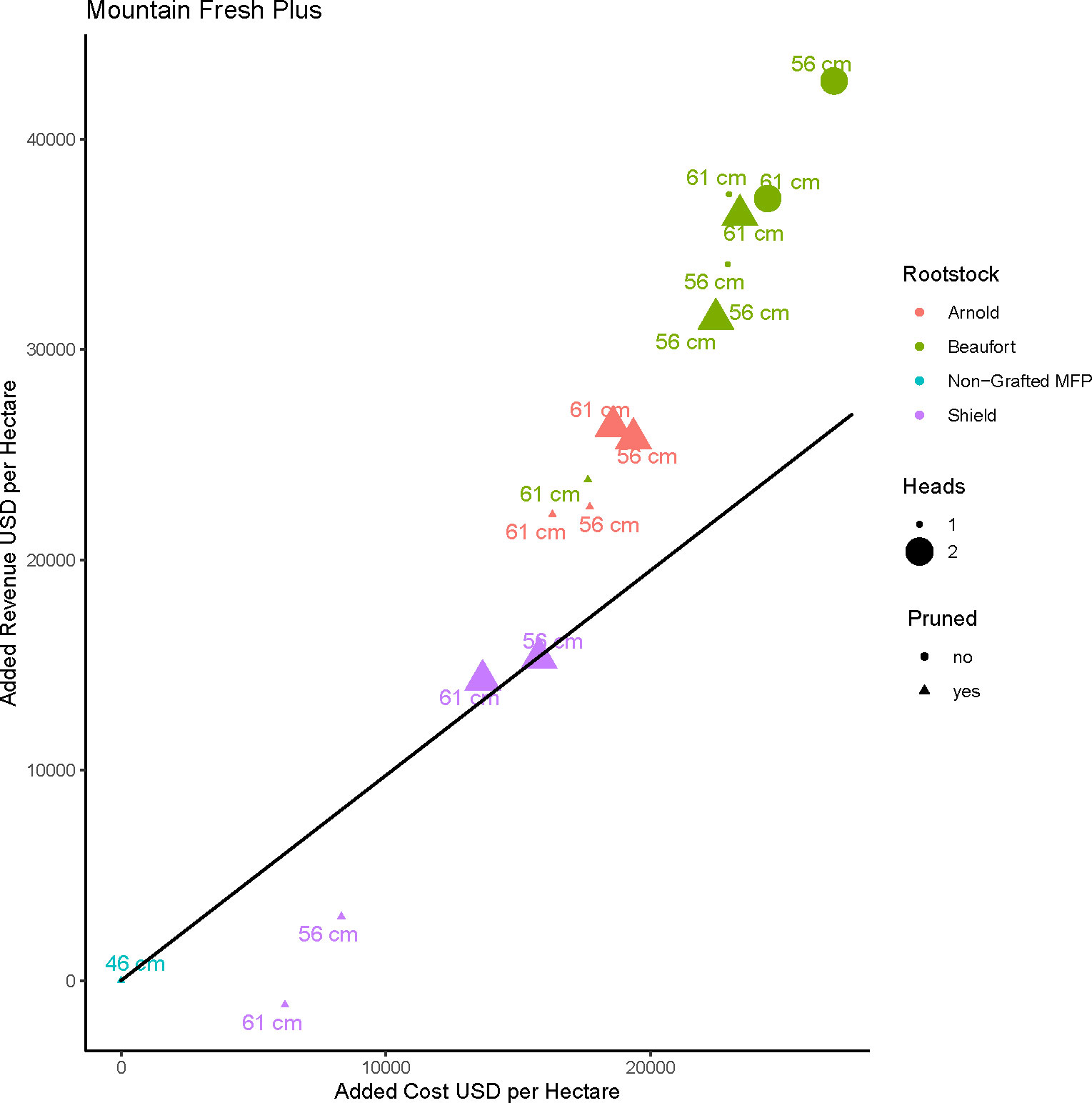
Figure 7 Partial-budget analysis of grafted tomatoes grown in 2017 and 2018. Scatter plot of added revenue in MFP tomatoes (compared to non-grafted grower standard) in USD per hectare, compared to the added cost in United States Dollars (USD) (compared to the cost of the non-grafted grower standard) per hectare. Total added cost USD per hectare includes fixed costs per hectare (grafting, seed, pinching, pruning) added to scaling costs (picking and packing costs of added yield).

Figure 8 Cost-benefit analysis of grafted tomatoes grown in 2017 and 2018. Scatter plot of added revenue in TL tomatoes (compared to non-grafted grower standard) in USD per hectare, compared to the added cost in United States Dollars (USD) (compared to the cost of the non-grafted grower standard) per hectare. Total added cost USD per hectare includes fixed costs per hectare (grafting, seed, pinching, pruning) added to scaling costs (picking and packing costs of added yield).
Grafting tomatoes onto the rootstocks ‘Arnold’ and ‘Beaufort’ consistently increased marketable yield of fresh market tomatoes produced in the field in this study. This fits into a larger body of evidence that shows certain rootstocks can provide yield and fruit sizing benefits to growers (Rivard et al., 2010b; Grieneisen et al., 2018) even in the absence of known negative abiotic and biotic constraints. The most significant gains in fruit size increase were in TL at the XLPlus size when grafted onto ‘Arnold’ and ‘Beaufort’ at 74% and 94% respectively for TL, and 30% and 25% for MFP. These data give a strong indication that one mechanism of grafting is to increase fruit size for cultivars like TL. The most likely explanation is that TL, a lower yielding but high fruit quality cultivar, naturally has less vigor than MFP and therefore responded proportionately more to the beneficial impact of the rootstock treatments. Other studies have shown that MFP does not appear to benefit from grafting, specifically on the rootstock ‘Maxifort’ (Grieneisen et al., 2018; Lang and Nair, 2019). The grafted tomatoes in our study were planted at a greater spacing than non-grafted plants (56 and 61 cm vs 46 cm) yet still produced significantly higher yields with the two rootstocks. In contrast, the rootstock ‘Shield’ did not confer an advantage in the absence of bacterial wilt pressure (Table 2).
Although the overall effect of spacing had no significant effect on yield, the highest yielding treatment were unpruned TL grafted onto ‘Beaufort’, non-pinched, planted at 61 cm spacing (128121 and 120358 total kg/ha for 2017 and 2018 respectively) (Supplemental Table S3). The identical treatment at 56 cm spacing had lower, but still significantly high total yields in 2017 and 2018 at 114495 and 102324 kg/ha (Supplemental Table S3). This indicates that there may be specific circumstances where a small increase in spacing could result in significant increases in yield, and more detailed research is needed to elucidate this. Research tailored for specific cultivars may define winning combinations of techniques. Also, when using 56 and 61 cm spacing, 18-25% fewer plants per hectare are needed for yields equivalent to using non-grafted plants at 46 cm spacing. Because there were no consistent significant differences in overall yield or fruit sizes in 56 compared to 61 cm spaced grafted plants, it is recommended that growers plant grafted plants at 61 cm. This agrees with Suchoff et al., 2014 that show spacing grafted plants (non-pinched) tends to be optimized around 61 cm.
Pinching grafted tomatoes did not provide a consistent benefit at 56 and 61 cm across years. It is likely that the spacing differences were too small to show a significant benefit to pinching. It should also be mentioned that both pinching and not pruning plants increased yields ~10%, but the effect is not additive (Ingram et al., 2019). Increasing the foliage with either technique may allow the plant to take advantage of the more vigorous root system of the tomato rootstock (Davis and Estes, 1993; Kanyomeka and Shivute, 2005; Gaytán-Mascorro et al., 2008; Maboko et al., 2011). To see a more consistent effect of pinching or not pruning, future studies should include wider spacings (>61 cm) to accommodate the additional foliage created by grafted pinched or non-pruned plants. Increasing spacing for pinched plants may be the key to offsetting the costs related to pinching. Also, not pruning pinched varieties may be an important component in maximizing foliage while minimizing planting costs. Pinching is an added cost for growers and the optimal parameters under which this practice is used needs to be studied further before widescale adoption by growers in the field. More details on the pruning and pinching interactions are reported in a separate publication (Ingram et al., 2019).
While both ‘Beaufort’ and ‘Arnold’ provided clear return on investments (ROI) in both scions, ‘Beaufort’ consistently provided the highest ROI (Figures 7, 8). ‘Shield’ provided the lowest ROI, and in some cases had less yield than the non-grafted controls. While pinching did not provide a clear benefit in ‘Beaufort’ or ‘Arnold’, pinched ‘Shield’ plants did provide a clear ROI. The cost-benefit patterns were similar between TL and MFP. Overall, these results demonstrate that there is a clear economic benefit to grafting in field situations where there is low or no disease present. Shield is typically used to combat bacterial wilt diseases, but bacterial wilt can often have an uneven distribution in fields. One method growers might be able to justify the cost of using bacterial wilt resistant cultivars that lack vigor, would be to pinch them, as this can have a clear impact on yield that can provide a higher ROI. While the cost of pruning is negligible compared to the cost of grafted plants, there was no clear benefit to pruning determinate cultivar tomatoes in this field according to Ingram et al., 2019, which is included in our analysis (Figures 7, 8).
Despite some significant differences, overall changes in fruit quality from grafted and non-grafted plants may not result in perceptible differences in taste. Turhan et al. (2011) found that SSC was consistently higher in fruit from non-grafted plants compared to those from ‘Arnold’ and ‘Beaufort’, but was 0.4%, less than the 2% SSC generally thought to be needed for consumers to detect differences in sweetness. In contrast, other research studies have found that grafting has no significant positive or negative effect on overall tomato fruit quality (Pogonyi et al., 2005; Davis et al., 2008; Gaytán-Mascorro et al., 2008).
Rootstocks ‘Arnold’, Beaufort’, and ‘Fortamino’ all significantly improved yields and, sometimes, fruit size in ‘Tasti-lee’ and ‘Mountain Fresh Plus’ grafted plants compared to the non-grafted plants. Of the grafted plants, scions grafted onto ‘Shield’ produced the lowest yields, on average, and were not significantly different than the non-grafted plants. This trial was conducted in the absence of known biotic or abiotic stress factors. The 61-cm spaced plants had similar yields to 56-cm spaced plants, indicating that growers can plant fewer grafted plants and achieve similar yields and fruit sizes. Across all combinations, pinching grafted tomato plants increased yield in only one year, so more research ought to be conducted before recommending this practice. Pinching only provided a specific benefit to plants grafted with ‘Shield’, otherwise the effect was marginal. More research needs to be done on wider plant spacings to determine if spacing greater than 61-cm would see benefits from pinching. In the cultivar ‘Tasti-Lee’, fruit quality characteristics such as lycopene, titratable acidity%, SSC%, and pH differed in grafted and non-grafted plants. Grafting with ‘Arnold’ and ‘Beaufort’ consistently improved yields in both years and show a clear economic benefit. There was no specific economic benefit to pinching except with the rootstock ‘Shield’. This study provides a clear outline of best practices for grafting in field conditions under low-disease conditions.
The raw data supporting the conclusions of this article will be made available by the authors, without undue reservation.
TI, FL, and IM were responsible for the experimental design of the field study. TI, SS, and IM executed the field experiment and data collection. MT and PP-V were responsible for the fruit quality study. TI conducted the data analysis and wrote the manuscript. All authors contributed to the article and approved the submitted version.
This work was funded by the USDA-NIFA specialty crop research initiative under award number 2016-51181-25404. Additional sources of funding and/or resources include the NC Agricultural Foundation, Inc., NC Tomato Growers Association. Tri-Hishtil provided all the grafted plants used in this study, and Bejo Seeds, Inc. provided all the seed used in this study.
We would like to thank Ryan Loudy and all the staff at the Mountain Horticultural Crops Research and Extension Center for their assistance with executing this research.
The authors declare that the research was conducted in the absence of any commercial or financial relationships that could be construed as a potential conflict of interest.
All claims expressed in this article are solely those of the authors and do not necessarily represent those of their affiliated organizations, or those of the publisher, the editors and the reviewers. Any product that may be evaluated in this article, or claim that may be made by its manufacturer, is not guaranteed or endorsed by the publisher.
The Supplementary Material for this article can be found online at: https://www.frontiersin.org/articles/10.3389/fhort.2022.1091342/full#supplementary-material
Adhikari T. B., Gao A., Ingram T., Louws F. J. (2020). Pathogenomics characterization of an emerging fungal pathogen, Fusarium oxysporum f. sp. lycopersici in greenhouse tomato production systems. Front. Microbiol. 11, 1995. doi: 10.3389/fmicb.2020.01995
Barrett C. E., Zhao X., Hodges A. W. (2012). Cost benefit analysis of using grafted transplants for root-knot nematode management in organic heirloom tomato production. HortTechnology 22, 252–257. doi: 10.21273/HORTTECH.22.2.252
Chen T., Liu Y., Huang L. (2022). ImageGP: An easy-to-use data visualization web server for scientific researchers. iMeta 1, e5. doi: 10.1002/imt2.5
Davis J. M., Estes E. A. (1993). Spacing and pruning affect growth, yield, and economic returns of staked fresh-market tomatoes. J. Am. Soc. Hortic. Sci. 118, 719–725. doi: 10.21273/JASHS.118.6.719
Davis A. R., Perkins-Veazie P., Hassell R., Levi A., King S. R., Zhang X. (2008). Grafting effects on vegetable quality. HortScience 43, 1670–1672. doi: 10.21273/HORTSCI.43.6.1670
Gaytán-Mascorro A., Castellanos-Ramos J. Z., Villalobos-Reyes S., Díaz-Pérez J. C., Camacho-Ferre F. (2008). Response of grafted tomato plants (Lycopersicon esculentum mill.) to leaf pruning and nutrient solution concentration. J. Food Agric. Environ. 6, 269–277.
Grieneisen M. L., Aegerter B. J., Stoddard C. S., Zhang M. (2018). Yield and fruit quality of grafted tomatoes, and their potential for soil fumigant use reduction. a meta-analysis. Agron. Sustain. Dev. 38, 29. doi: 10.1007/s13593-018-0507-5
Grimault V., Prior P. (1994). Grafting tomato cultivars resistant or susceptible to bacterial wilt: Analysis of resistance mechanisms. J. Phytopathol. 141, 330–334.
Harrison D. J., Burgess P. G. (1962). Use of rootstock resistance for controlling fusarium wilt of tomatoes. Plant Pathol. 11, 23–25. doi: 10.1111/j.1365-3059.1962.tb00153.x
Ingram T., Sharpe S., Louws F. J., Meadows I. (2019). “Pruning reduces yields in grafted tomatoes planted in the field,” in II International Symposium on Vegetable Grafting, (Acta Horticulturae Miguel 2002) 1302, 65–72. Available at: http://wwww.minagric.gr/greek/data/conference_proceedings.pdf.
Ioannou N. (2001). Integrating soil solarization with grafting on resistant rootstocks for management of soil-borne pathogens of eggplant. J. Hortic. Sci. Biotechnol. 76, 396–401. doi: 10.1080/14620316.2001.11511383
Ivors K. (2010). Commercial production of staked tomatoes in the southeast. AG–405, North Carolina Coop. Ext. Serv. Bul. (North Carolina State University) Available at: https://hortintl.cals.ncsu.edu/sites/default/files/documents/commercialproductionofstakedtomatoesinthesoutheast.pdf.
Kanyomeka L., Shivute B. (2005). Influence of pruning on tomato production under controlled environments. Agricultura Tropica Subtropica 38, 79–83.
Kubota C., McClure M. A., Kokalis-Burelle N., Bausher M. G., Rosskopf E. N. (2008). Vegetable grafting: History, use, and current technology status in north America. HortScience 43, 1664–1669. doi: 10.21273/HORTSCI.43.6.1664
Kyriacou M. C., Rouphael Y., Colla G., Zrenner R., Schwarz D. (2017). Vegetable grafting: The implications of a growing agronomic imperative for vegetable fruit quality and nutritive value. Front. Plant Sci. 8, 741. doi: 10.3389/fpls.2017.00741
Lang K. M., Nair A. (2019). Effect of tomato rootstock on hybrid and heirloom tomato performance in a Midwest high tunnel production system. HortScience 54, 840–845. doi: 10.21273/HORTSCI13874-19
Lee J.-M. (1994). Cultivation of grafted vegetables i. current status, grafting methods, and benefits. HortScience 29, 235–239. doi: 10.21273/HORTSCI.29.4.235
Loewen D. E., Pliakoni E., Rivard C. L. (2019). “Evaluating Capsicum and Solanum rootstocks for fresh-market bell pepper production,” in II International Symposium on Vegetable Grafting, Vol. 1302. 259–264.
Louws F. J. (2010). “IPM for soilborne disease management for vegetable and strawberry crops in SE USA,” in Recent developments in management of plant diseases (Springer), 217–227. Available at: https://link.springer.com/chapter/10.1007/978-1-4020-8804-9_16.
Louws F. J., Rivard C. L., Kubota C. (2010). Grafting fruiting vegetables to manage soilborne pathogens, foliar pathogens, arthropods and weeds. Scientia Hortic. 127, 127–146. doi: 10.1016/j.scienta.2010.09.023
Maboko M. M., Du Plooy C. P., Chiloane S. (2011). Effect of plant population, fruit and stem pruning on yield and quality of hydroponically grown tomato. Afr. J. Agric. Res. 6, 5144–5148.
Miguel A. (2002). “Grafting as a non-chemical alternative to methyl bromide for tomato in Spain,” in Proceedings of International Conference on Alternatives to Methyl Bromide œ, (Acta Horticulturae Miguel 2002) 283. Available at: http://wwww.minagric.gr/greek/data/conference_proceedings.pdf.
Oztekin G. B., Giuffrida F., Tuzel Y., Leonardi C. (2009). Is the vigour of grafted tomato plants related to root characteristics. J. Food Agric. Environ. 7, 364–368.
Panthee D. R., Perkins-Veazie P., Randall D., Brown A. F. (2013). Lycopene estimation in tomato lines using infrared absorbance and tomato analyzer. Int. J. Vegetable Sci. 19, 240–255. doi: 10.1080/19315260.2012.715324
Pogonyi A., Pék Z., Helyes L., Lugasi A. (2005). Effect of grafting on the tomato’s yield, quality and main fruit components in spring forcing. Acta Alimentaria 34, 453–462. doi: 10.1556/AAlim.34.2005.4.12
Qiao K., Wang Z., Wei M., Wang H., Wang Y., Wang K. (2015). Evaluation of chemical alternatives to methyl bromide in tomato crops in China. Crop Prot. 67, 223–227. doi: 10.1016/j.cropro.2014.10.017
Rahmatian A., Delshad M., Salehi R. (2014). Effect of grafting on growth, yield and fruit quality of single and double stemmed tomato plants grown hydroponically. Horticulture Environment Biotechnol. 55, 115–119. doi: 10.1007/s13580-014-0167-6
Riga P., Benedicto L., García-Flores L., Villaño D., Medina S., Gil-Izquierdo Á. (2016). Rootstock effect on serotonin and nutritional quality of tomatoes produced under low temperature and light conditions. J. Food Composition Anal. 46, 50–59. doi: 10.1016/j.jfca.2015.11.003
Rivard C., O’Connell S., Peet M., Louws F. (2010b). Grafting tomato with interspecific rootstock to manage diseases caused by Sclerotium rolfsii and southern root-knot nematode. Plant Dis. 94, 1015–1021. doi: 10.1094/PDIS-94-8-1015
Rivard C. L., Sydorovych O., O’Connell S., Peet M. M., Louws F. J. (2010a). An economic analysis of two grafted tomato transplant production systems in the united states. HortTechnology 20, 794–803. doi: 10.21273/HORTTECH.20.4.794
Rivero R. M., Ruiz J. M., Romero L. (2003). Role of grafting in horticultural plants under stress conditions. J. Food Agric. Environ. 1, 70–74.
Rysin O., Louws F. J. (2015). Decision tool for growers to evaluate economic impact of grafting technology adoption: An application to open-field conventional tomato production. HortTechnology 25, 132–138. doi: 10.21273/HORTTECH.25.1.132
Suchoff D. H., Gunter C. C., Schultheis J. R., Hassell R. L., Louws F. J. (2019). The effect of grafting on nitrogen use in determinate field-grown tomatoes. J. Hortic. Sci. Biotechnol. 94, 102–109. doi: 10.1080/14620316.2018.1450645
Suchoff D., Gunter C., Schultheis J., Louws F. (2014). On-farm grafted tomato trial to manage bacterial wilt . Acta Horticult. 1086, 119–127. doi: 10.17660/ActaHortic.2015.1086.14
Turhan A., Ozmen N., Serbeci M., Seniz V. (2011). Effects of grafting on different rootstocks on tomato fruit yield and quality. Hortic. Sci. 38, 142–149. doi: 10.17221/51/2011-HORTSCI
World Bank (2015) Arable land (hectares per person). Available at: https://data.worldbank.org/indicator/AG.LND.ARBL.HA.PC.
Keywords: grafting, tomatoes, rootstocks, fruit quality, agronomics
Citation: Ingram TW, Sharpe S, Trandel M, Perkins-Veazie P, Louws FJ and Meadows I (2022) Vigorous rootstocks improve yields and increase fruit sizes in grafted fresh market tomatoes. Front. Hortic. 1:1091342. doi: 10.3389/fhort.2022.1091342
Received: 06 November 2022; Accepted: 12 December 2022;
Published: 22 December 2022.
Edited by:
Ertan Yildirim, Atatürk University, TurkeyReviewed by:
Laxman R. H., Indian Institute of Horticultural Research (ICAR), IndiaCopyright © 2022 Ingram, Sharpe, Trandel, Perkins-Veazie, Louws and Meadows. This is an open-access article distributed under the terms of the Creative Commons Attribution License (CC BY). The use, distribution or reproduction in other forums is permitted, provided the original author(s) and the copyright owner(s) are credited and that the original publication in this journal is cited, in accordance with accepted academic practice. No use, distribution or reproduction is permitted which does not comply with these terms.
*Correspondence: Inga Meadows, aW5nYV9tZWFkb3dzQG5jc3UuZWR1
Disclaimer: All claims expressed in this article are solely those of the authors and do not necessarily represent those of their affiliated organizations, or those of the publisher, the editors and the reviewers. Any product that may be evaluated in this article or claim that may be made by its manufacturer is not guaranteed or endorsed by the publisher.
Research integrity at Frontiers

Learn more about the work of our research integrity team to safeguard the quality of each article we publish.